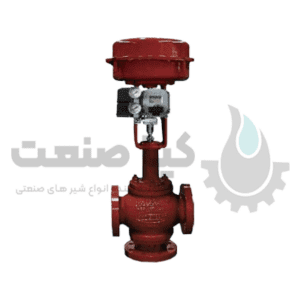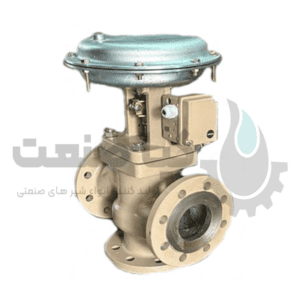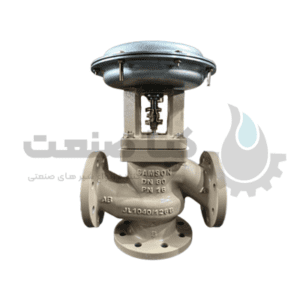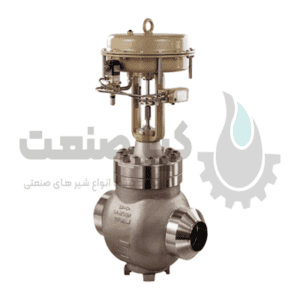
Your cart is empty!
Showing all 4 results
 برای سفارش و اطلاع از قیمت با ما تماس بگیرید
برای سفارش و اطلاع از قیمت با ما تماس بگیرید
 برای سفارش و اطلاع از قیمت با ما تماس بگیرید
برای سفارش و اطلاع از قیمت با ما تماس بگیرید
 برای سفارش و اطلاع از قیمت با ما تماس بگیرید
برای سفارش و اطلاع از قیمت با ما تماس بگیرید
 برای سفارش و اطلاع از قیمت با ما تماس بگیرید
برای سفارش و اطلاع از قیمت با ما تماس بگیرید
A control valve is a mechanical device used to regulate the flow of fluids, gases, or other materials through a pipeline.
It consists of body, actuator and positioner.
The control valve body controls the flow of material by opening or closing, while the actuator provides the energy needed to operate the valve.
The positioner senses the position of the valve and adjusts the actuator accordingly to maintain the desired flow rate, pressure or level.
Control valves are used in various applications such as oil refineries, chemical plants and water treatment plants.
A control valve or control valve regulates the flow of a fluid, such as gas, steam, water, or chemical compounds, to account for load disturbances and keep the controlled process variable as close to the target set point as possible.
A control valve is designed to regulate or control the flow of fluid or gas through a pipe by opening or closing a passage.
Control valves usually consist of valve body, valve trim, spring and stem.
The valve body consists of inlet and outlet connections and a passageway that can be opened or closed by the valve trim.
The valve trim is the internal part of the valve that is in contact with the fluid or gas and moves inside the valve body to control the flow.
This includes features such as a disc or ball that contacts the seat to regulate flow
The stem is used to move the valve trim and is usually connected to a mechanical or electrical actuator that provides the power to open or close the valve.
The spring provides the force to return the trim valve to the closed position when the actuator is not in use
A control valve operates by receiving a signal from a controller that measures a process variable (such as temperature, pressure, or flow) and determines whether the valve should be opened or closed to maintain the desired set point.
The controller sends a signal to the actuator, which then moves the valve stem.
Trim opens or closes the valve to adjust the flow and maintain the set point.
A control valve is a valve that is used to control fluid flow by changing the flow rate according to the signal of a controller.
It provides the possibility of direct control of flow rate and control of pressure, temperature and liquid level, which is called “final control element”.
Opening or closing of automatic control valves is usually done by electric, hydraulic or pneumatic actuators d
Air operated (pneumatic) valves are usually more common due to their ease of use, the most important reason being that only a source of compressed air is required.
While electrically operated valves require additional cabling and switchgear, and hydraulically operated valves require high pressure feed and return lines for hydraulic fluid.
A control valve is a type of valve that we use to control the flow, pressure, level or even the direction of the fluid according to the process needs.
There are different types of control valves such as globe valves, butterfly valves, diaphragm valves, etc.
We almost always like to have control over various process parameters like temperature, pressure, level etc.
To achieve this goal, it is obvious that we need a controller such as Programmable Logic Controller or PLC for short.
We also need some sensors and transmitters to send the data to the PLC or DCS.
Finally, we need a piece of equipment to execute PLC commands, commonly referred to as the “final control element”.
The control valve is used to start and stop the flow completely, and to control or adjust or in other words the gas valve of liquid (or fluid) flow.
How does a valve control affect the control loop?
Process plants consist of many control loops that are interconnected to produce a product.
Control loops are designed to maintain essential process variables such as fluid level, pressure, and temperature within specified limits.
This helps to ensure that the quality of the final product is optimal.
Each of these loops creates internal disturbances that may affect process variables.

The operator controls the mechanical valves in the field, but the valve control has the capability of remote control.
If required, the control valves will pass the safe failure conditions, while the mechanical valves will not be able to do so (Fail Open) or (Fail Close).
When control valves are used in a process system, the operator has to do less work because the parameters (flow, level and pressure) remain the same.
Having enough capacity for the required services
Keep the liquid without external leakage
able to withstand the corrosive, erosive and thermal effects of the process.
You should also ensure that the valve control actuator end fittings are suitable for mating with adjacent pipes and connecting mechanisms so that actuator thrust can be transferred to the valve stem or rotary shaft.
1- Flow valve control
It controls the flow by adjusting it.
The flow direction is determined and controlled by the flow direction.
2- pressure valve control
Check the pressure control valve to make sure it is at the desired level. In the event of a pressure increase, the overpressure protection safely releases the system pressure.
3- Temperature valve control
The pressure or flow of thermal fluid in compressors, heating coils, or other heating equipment is controlled by temperature regulators and temperature control valves (often referred to as TCVs).
4- level valve control
Through the use of a mechanical float that controls a small pilot valve to adjust the main valve, the level control valve was used to manage the filling of tanks and vessels.

How does the actuator control the amount of fluid flow?
Ball Valves
These valves can be controlled manually with a lever that also indicates whether they are open or closed, or automatically controlled by an actuator.
This type of valve allows for good liquid flow control and safe shutdown when closed.
They are often used in paper production, chemical industry and wastewater treatment.
These valves stop the flow of liquid in the pipeline from rotating.
The moving fluid keeps the control valves open.
The valve will close if the liquid flow is reversed.
This type of valve is usually used in thermal and hydropower sectors, for oil and gas transmission, in water and wastewater treatment facilities, and in oil and gas processing industries.
They are often used because they are portable and simple to use, and there is little pressure across the valve when the butterfly valve is open.
When you want full or no flow, gate valves work best as isolation or stop valves.
Due to the minimal flow resistance, the liquid flows in a straight path, losing little pressure when they are fully opened.
Globe Valves)
Globe valves have a special design that forces the passing fluid to go through the reverse direction twice.
By pulling the wire and eroding the seat, they are suitable for throttling and controlling current.
Although they are more expensive than gate valves, they have higher flow resistance.
These valves provide precise flow control.
They are often used for chemical feed control or continuous blasting services.
These valves are suitable for ON/OFF and current cut applications.
In plug valves, the branches can be conical or spherical. A slot is made in the plug to allow the fluid to flow. With only a quarter turn, it may be opened or closed, providing a straight line.
One or more orifices can be added to a valve to change the flow direction. There are lubricated and non-lubricated types.
Plug valves are useful for automatic process control operations
Parasite valves lead to fewer pipe connections and reduced pressure in the piping system.
Parasit valves can be used for corrosive liquids.
This type of valve control (pinch valve) can be used for suffocation and shutdown operations.
Low pressure drop, low initial cost and minimal maintenance costs are all advantages of pinch valves.
Flexible Diaphragm A diaphragm valve is a technique used to stop the flow of a valve.
This means that the straight type does not stretch the diaphragm enough to shorten its life.
Gate Valves and Globe Valves are among the most widely used industrial flow control valves.
Check Valves are mainly used in flow control to prevent pressure build up inside the system and control back flow.
In general, the commonly used flow control valves are:
1-Check valve
2- Butterfly valve
3- Valve gate
4- Globe valve
5- Needle valve
Pay attention to the following points to buy valve control:
Buy from a reputable supplier.
Check the technical specifications of the control valve carefully.
Get help from an expert to choose the right valve control.
In the following, some reliable valve control brands have been introduced in Iran:
You can get all kinds of valve controls from Kiasanat.
Copied to clipboard